There are about 10 major alloying elements of the Periodic System, which, in concentrations of between 0.1 and a few wt.-%, can be used to change significantly the properties of pure aluminium according to needs of the producer, fabricator or user.
Consequently, there is an abundance of aluminium alloys, which are currently in use. There are about 500 internationally registered wrought and cast aluminium alloy compositions, from which only little more than a dozen are used for the manufacture of automotive components and cars.
To select and specify an alloy with specific properties for a given application, its composition and state of heat treatment (temper) must be defined. This is achieved by a standardised designation system for the alloy composition as well as for the temper.
The global character of the European Market demanded a common designation system in lieu of various national varieties. For its simplicity and flexibility the designation system for wrought alloys created 1954 by the North American Aluminum Association (AA) was adopte d in 1970 by the International Organisation for Standardization (ISO).
In 1985 the member states of the European Community agreed to adopt harmonised European standards in place of respective national ones. For wrought aluminium, the AA designation system was adopted by the Comité Europeén de Normalisation (CEN), but for cast alloys a separate designation standard was developed.
Since the new CEN standards for aluminium alloy and temper designation have replaced previous European national standards, they will be adopted - where applicable - in this Automotive Manual and are described briefly hereafter for wrought and cast aluminium alloys.
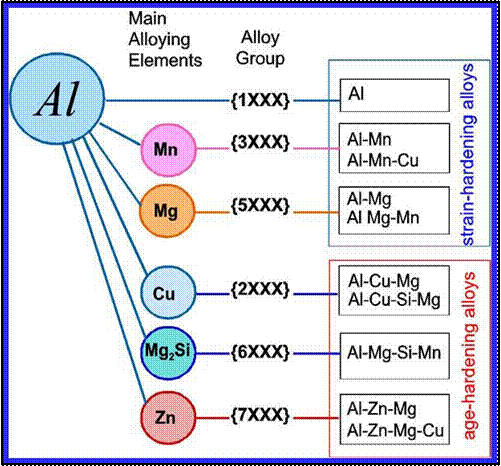
Wrought aluminium and aluminium alloys: these alloys are primarily intended for the production of wrought products by hot and/or cold working, i.e. rolling, extruding, forging and drawing.
They are cast in ingots by direct chill (DC) casting or strip casting processes prior to hot and/or cold working.
Wrought aluminium alloys can be divided into groups of heat-treatable and non-heat- treatable alloys:
- Heat-treatable alloys are capable of being strengthened by suitable thermal treatment.
- Non-heat-treatable alloys cannot be strengthened substantially by thermal treatment.
Their basic strength is determined by the alloying content, but can be increased significantly by work-hardening and in some cases also by grain size refinement.
The specification of typical or minimum properties requires the combination of a unique designation for the alloy composition and for the temper, i.e. the state of the microstructure by thermo-mechanical treatment.
For optimum performance during hot and cold working, wrought alloys are tailored to the specific semi-fabrication process. Consequently, the properties of a specified alloy and temper may vary, dependent on the type and dimensions of the semi-product.
(ANSI Standard H35.1(M)-1997)
The registration office for designations of aluminium and aluminium alloys and tempers is The Aluminum Association Inc., Washington, DC. (AA).
This standard is also the basis for wrought aluminium and aluminium alloy and temper designation standards of ISO and CEN, which therefore permits cross reference between these designation standards.
Alloys registered within the American National Standard are identified by the pre-fix "AA". Example: AA 5754
The alloy and temper designation system of ISO/DIS 209 is basically identical with that of AA, but alloys are not preceded by the letters AA.
The current ISO alloy designation also uses chemical symbols. However, it has been recently decided to fully adopt the four digits alloy designation system and withdraw the chemical symbols system. The revised standards are not yet valid, but designation by chemical symbols acc. to the valid ISO standards are no more used.
Example: 5754
The European wrought alloy (EN standards EN 573) and temper (EN standards EN 515)
designation system is basically identical with the ANSI (or AA) and ISO system.
Alloys standardized by EN 573-3 are also registered by the AA, but not all alloys registered by the AA are standardized by EN 573-3 and vice versa. Therefore, alloys designated according to EN must be preceded by the prefix EN AW (i.e. Aluminium Wrought).
Example: EN AW-5754 or EN AW-Al Mg3
The EN designation system for wrought alloy composition is made up of the following:
- EN for European standard followed by a space
- Letter A for aluminium
- Letter W for wrought (followed by a dash)
- Alloy composition is specified either by
Example a): EN AW-5754-O Example b): EN AW-Al Mg3-O
A 4-digit numerical system is used. The first digit indicates the alloy group as follows:
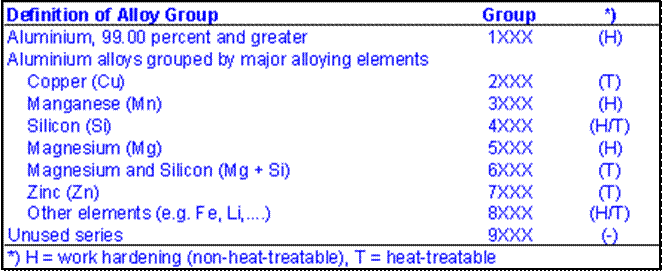
The last two digits identify the aluminium alloy or indicate the aluminium purity. The second digit indicates modifications (1...9) of the original alloy or impurity limits.
The heat treatment (temper) designation system of EN 515 is used for all forms of wrought aluminium and aluminium alloys. Property (mechanical or physical) limits apply to individual alloy-temper-product combinations.
- Basic temper designations consist of letters (F, O, H, W, T).
- One or more digits following the letter, where required, indicate sub-divisions of the basic tempers. These designate specific sequences of basic treatments.
- Additional digits are added to the designation, if some variation of the same sequence of basic thermo-mechanical operations should be applied to the same alloy, resulting in substantially different characteristics.
Note that ANSI H35.1(M) is not fully compatible with EN 515.
For the purpose of the standard temper designations, the following definitions are applied.
Cold working: Plastic deformation of metal at such temperature and rate that strain- hardening occurs.
Strain-hardening: Modification of a metal structure by cold working resulting in an increase in strength and hardness with loss of ductility.
Solution heat-treating: A thermal treatment which consists of heating the products to a suitable temperature, holding at that temperature long enough to allow constituents to enter solid solution and cooling rapidly enough to hold the constituents in solution.
Ageing: Precipitation from supersaturated solid solution resulting in a change in properties of an alloy, usually occurring slowly at room temperature (natural ageing) and more rapidly at elevated temperatures (artificial ageing).
Annealing: A thermal treatment to soften metal by removal of strain-hardening or by coalescing precipitates from solid solution.
- no mechanical property limits specified.
- to obtain the lowest strength temper.
- cold worked after annealing (or after hot forming) or in combination with partial annealing or stabilizing
- unstable temper, only with indication of ageing time at RT: e.g W 1/2 h.
- solution heat treated and aged at room or intermediate temperatures with or without supplementary strain-hardening
The designations (below) give a brief survey over the various temper designations for non- heat-treatable wrought aluminium and aluminium alloys. For more extensive information, please refer to EN 515.
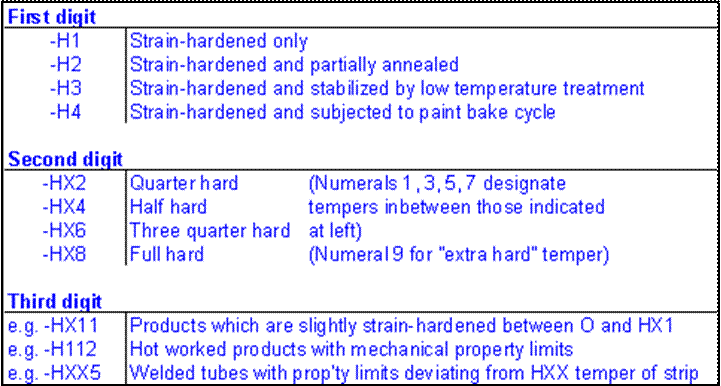
For mechanical property limits the user is referred to the respective product standards, e.g. EN 485-2 for sheet, strip and plate or special suppliers’ information.
The designations (below) give a brief survey over the various temper designations for heat- treatable wrought aluminium and aluminium alloys. For more extensive information, please refer to EN 515.
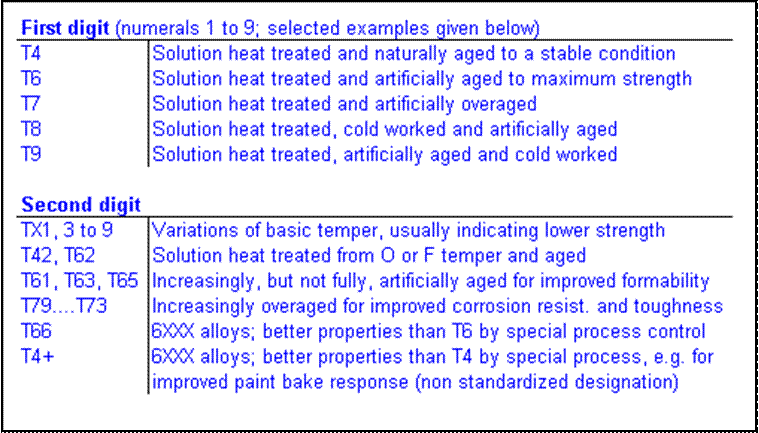
For mechanical property limits the user is referred to the respective product standards, e.g.
- EN 485-2 for sheet, strip and plate,
- EN 755-2 for extruded products,
- EN 586-2 for die forgings, or special suppliers information.
Casting aluminium and aluminium alloys are primarily intended for the production of
castings by solidification of the molten alloy in a mould.
The properties of castings are related to the composition of the castings alloy, but also significantly by the type of mould and mould filling processes, i.e. the casting processes employed. Casting alloys are tailored to the casting process.
For this reason the basic casting process used is part of the casting alloy designation system.
Contrary to the international systems of wrought aluminium alloy designation (AA, ISO, CEN), the designation systems for casting alloys and castings differ significantly.
In the efforts to develop a unified European designation system for casting alloys and castings the standards EN 1780 (designation of alloys) and EN 1706 (composition and mechanical properties, incl. temper designations) were developed, which deviate from the widely used ANSI (AA) system. To aid cross referencing, both systems are described in this chapter.
Specifically, the AA system defines 8 groups of casting alloys, whereas the EN system only differentiates between 4 alloy groups and excludes the tin containing bearing alloys.
The EN designation system for wrought alloy composition is made up of the following:
- EN for European standard,
- Letter A for aluminium
- Letter C for casting
- Alloy composition is specified either by
Example:
EN AC-42000KT6 (alloy Al 7%SiMg for chill or permanent mould casting, aged to T6 temper)
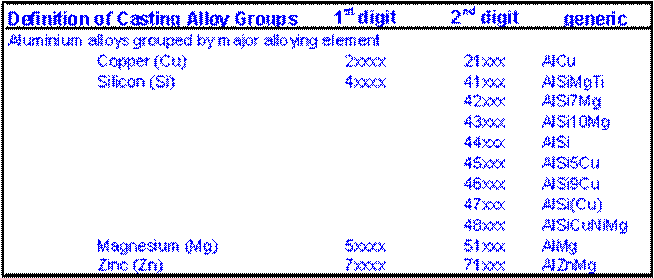
The 3rd digit is arbitrary and defines the generic alloy modification. The 4th digit is generally 0. The 5th digit is always 0 for CEN alloys, but never 0 for aerospace alloys.
- Al followed by a space
- Symbol of the major alloying element usually followed by the percentage of mass
- Other alloying elements (max. 4 elements) in descending order; if the mass fractions are the same, in alphabetical order
- In case of similar composition, the difference is made by:
Example: EN AC-Al Si7Mg0.3, EN AC-Al Si7Mg0.6
or
Example: EN AC-Al Si10Mg(Cu)
The first letter after the 5 alloy numerals or chemical symbols characterises the casting process. The following symbols are used:
D: Pressure die casting
K: Chill or permanent mould casting
L: Investment casting
S: Sand casting Example: EN AC-42000K
The conditions of thermal treatment of castings as defined by EN 1706 are as follows:

Following is an example for a complete designation of a permanent mould casting of casting alloy 42100, solution annealed and artificially aged, according to EN 1706:
Example: EN 1706 AC-42100KT6
All details about the European designation refer to the publications: EN 1780: 1999-12 and EN 1706: 1998-06, respectively.
Cast Aluminium and Aluminium Alloy Designation System (ANSI H35.1(M)-1997) uses a 4 digit numerical designation.
The 1st digit identifies the alloy group. The 2nd two digits determine the alloy or indicate the aluminium purity. The last digit - separated by a decimal point - indicates the product form, i.e. castings (0) or ingot (1, 2).
A modification of the original alloy or impurity limits is indicated by a serial letter before the numerical designation.
Example: A356.0 (AlSi7Mg0.3)
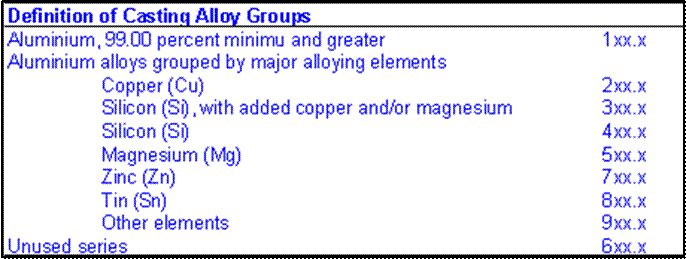
Alloys are registered with Aluminium Association Registration Record (AA). The designation system is identical to the specification J452 and J453 of the SAE (Society of Automotive Engineers).
Source: https://www.european-aluminium.eu/media/1533/aam-materials-3-designation-system.pdf
Web site to visit: https://www.european-aluminium.eu
Author of the text: indicated on the source document of the above text
If you are the author of the text above and you not agree to share your knowledge for teaching, research, scholarship (for fair use as indicated in the United States copyrigh low) please send us an e-mail and we will remove your text quickly. Fair use is a limitation and exception to the exclusive right granted by copyright law to the author of a creative work. In United States copyright law, fair use is a doctrine that permits limited use of copyrighted material without acquiring permission from the rights holders. Examples of fair use include commentary, search engines, criticism, news reporting, research, teaching, library archiving and scholarship. It provides for the legal, unlicensed citation or incorporation of copyrighted material in another author's work under a four-factor balancing test. (source: http://en.wikipedia.org/wiki/Fair_use)
The information of medicine and health contained in the site are of a general nature and purpose which is purely informative and for this reason may not replace in any case, the council of a doctor or a qualified entity legally to the profession.
The texts are the property of their respective authors and we thank them for giving us the opportunity to share for free to students, teachers and users of the Web their texts will used only for illustrative educational and scientific purposes only.
All the information in our site are given for nonprofit educational purposes